Happy Lunar New Year from the USC US-China Institute!
Competing International Buddhisms: Yu Guanbin’s Contribution to Taixu’s Buddha-ization Movement in 1920-30s Shanghai
This talk concerns the work of the prominent Korean lay Buddhist and entrepreneur Oak Kwanbin (1891-1933) in Shanghai during the mid-1920s and early-30s. Oak collaborated with the Chinese Buddhist reformer Taixu (1890–1947) to promote a transnational Buddhist discourse called “the Buddha-ization movement” (fohua yundong). Oak also acted as a bridge between Korean and Chinese Buddhism by undertaking the project of rebuilding an eleventh-century Korean temple, Koryŏsa, in Hangzhou.

This talk concerns the work of the prominent Korean lay Buddhist and entrepreneur Oak Kwanbin (1891-1933) in Shanghai during the mid-1920s and early-30s. Oak collaborated with the Chinese Buddhist reformer Taixu (1890–1947) to promote a transnational Buddhist discourse called “the Buddha-ization movement” (fohua yundong). Oak also acted as a bridge between Korean and Chinese Buddhism by undertaking the project of rebuilding an eleventh-century Korean temple, Koryŏsa, in Hangzhou. In this talk, Kim examines how Oak's engagement in these projects is a distinctive case of modern East Asian Buddhism in which national/transnational and religious/political visions intersected and conflicted with each other.
Hwansoo Kim is an assistant professor at Duke University in the field of Korean Buddhism and culture with the departments of Religion and Asian & Middle Eastern Studies. He received his doctorate from Harvard University in 2007, followed by a post-doctoral appointment with the Harvard Reischauer Institute. He then taught Japanese religions as an assistant professor at the University of Arizona. Kim’s most recent article is “ ‘The Mystery of the Century’: Lay Buddhist Monk Villages (Chaegasŭngch’on) Near Korea’s Northernmost Border, 1600s–1960s.” He is the author of "Empire of the Dharma: Korean and Japanese Buddhism, 1877–1912" (Harvard Asia Press, 2013).
Featured Articles
We note the passing of many prominent individuals who played some role in U.S.-China affairs, whether in politics, economics or in helping people in one place understand the other.
Events
Ying Zhu looks at new developments for Chinese and global streaming services.
David Zweig examines China's talent recruitment efforts, particularly towards those scientists and engineers who left China for further study. U.S. universities, labs and companies have long brought in talent from China. Are such people still welcome?






